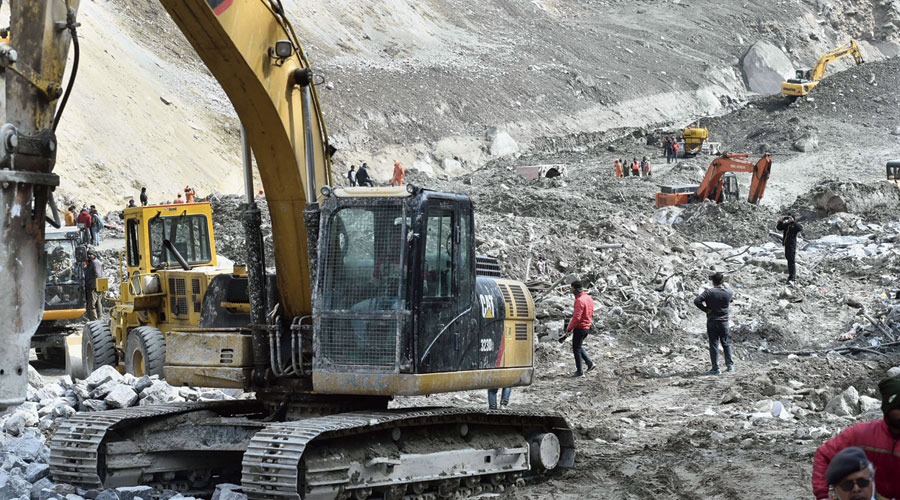Rescue teams on Saturday began widening a hole drilled into an approach tunnel on the way to the possible location of over 30 people trapped inside a sludge-choked tunnel of the NTPC’s Tapovan-Vishnugad hydel project after a flash flood ravaged the area on Sunday.
“We are working on a three-pronged strategy to reach those trapped in the tunnel. The hole we drilled yesterday is being widened to 1ft so as to reach a camera and a pipe inside the silt-flushing tunnel where the trapped are said to be located,” general manager of the NTPC project, R.P. Ahirwal, said.
A hole with a diameter of 1ft will help send in a camera to ascertain their location and a pipe to flush out accumulated water from the tunnel, Ahirwal said.
The other two parts of the strategy are clearing the desilting basin of the NTPC barrage through which muck is constantly flowing into the tunnels and restoring the flow of the Dhauliganga river to the right. The river’s flow has tilted to the left after the flash flood, hampering the sludge-clearing operation, Ahirwal said.
Describing the rescue of people as a priority, he said the NTPC had put more than 100 of its scientists on the job.
Asked whether an attempt could also be made to send rescue personnel to the possible location of those trapped inside the tunnel through the hole, the GM said it would need to be widened further for that and would be done if the need arose.
“More than 100 of our scientists are on the job. They are devising strategies and having them implemented,” Ahirwal said.
He said all resources and mechanical equipment required for the operation were available at the project site.
However, citing the conditions inside the tunnel, he said: “We can operate only with a few machines at a time. The rest of them have to be kept on standby because our strategy is to keep the operations underway round the clock.”
If for some reason an equipment stops working, there are alternatives on standby to ensure that the operations do not stop, he said.
Ahirwal said many experienced workers of the project were missing since the calamity and those put on the job were new people.
Talking about the biggest challenge being faced by the rescue team, the NTPC official said: “The rescue personnel are going to the tunnel where the men are likely to be trapped. Muck is constantly coming down from the NTPC barrage (above the tunnel) and its desilting basin, hampering the rescue effort. The water of the Dhauliganga too is coming into our tunnels through the desilting basin as it has tilted to the left after the avalanche. Restoring the flow of the Dhauliganga to the right is a big part of our strategy.”
The sludge-choked contours and conduits of the barrage’s desilting basin can also be removed more effectively only if the flow is restored to its earlier position.
The work on restoring the flow of the Dhauliganga has begun with the help of heavy machines, Ahirwal said.
Vijay Rana, a local resident who said he had worked on the construction of the tunnels, said he and some other people were not far from the Rishiganga when the flash flood washed away a hydro-power project at Raini village. “Jeet Singh Thakur, a deputy general manager of the NTPC, had entered the tunnel near the Rishiganga barely two-three minutes before the flash flood in a Mahindra Bolero car,” Rana said.
“A crane had also gone inside. We know Thakur for long. He was involved in the construction of the tunnel and he must be aware how to protect himself and the other workers in an emergency. Usually, workers come for work in the morning after having breakfasts. Some of them carry lunch packs. The rescuers have told us that it is possible to survive for seven days without food in case there is enough oxygen to breath. We are hopeful,” Rana added.
Relatives of the missing workers on Saturday gheraoed Anil Kumar, the sub-divisional magistrate of Chamoli, a little distance from the rescue site, demanding that the search be expedited. They had surrounded some administrative and NTPC officials on Friday.
Sanjay Kumar, a resident whose relative is missing, said: “Prime Minister Narendra Modi has said his government will provide every support to the state for the rescue operation. We fail to understand why the state government is still so slow. Why didn’t they use a heavy drill machine on the first day itself?”
So far, 38 bodies have been recovered from the affected areas while 166 are still missing.
DIG Nilesh Anand Bharne said 11 of the dead had been identified. Eighteen body parts have also been recovered from the flood-hit areas, of which 10 have been cremated after taking their DNA samples, he said.
The State Emergency Operation Centre here said scientists of the Indian Institute of Remote Sensing, during an aerial survey of the Rishiganga, had found that a glacial lake formed due to the avalanche over it had begun to release water, which has reduced the chances of it breaching or causing a fresh flash flood.










